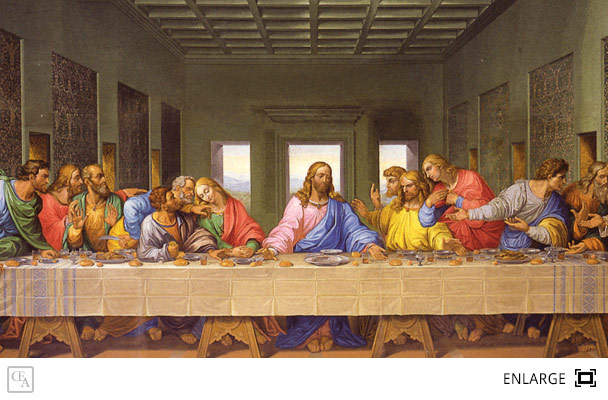
It is a quintessential example of Christian Renaissance art, and I depicts the infamous scene from John 13:21 in the Bible, where Jesus, surrounded by his disciples, reveals that one of the men will soon betray him. The painting captures the moment of the apostles' reactions in a vivid way, depicting each one of their personalities in motion.
Though it does depict a Biblical story, the piece is much more than just religious artwork, as its composition is extremely complex. Da Vinci's use of perspective and his focus on the psychology of the subjects make it one of the earliest pieces of true renaissance art, establishing many of the aesthetic conventions of this movement. Its striking beauty would later inspire many imitators.
To allow himself to modify the painting more easily as he worked on it, Da Vinci used an odd technique that was inappropriate for frescoes—instead of wet painting, he used tempera and oils to paint after first sealing the stone of the wall with dry plaster. In other words, he worked on a dry surface instead of the usual wet plaster that is typical of a true fresco. His experiment was not very successful, and the painting has not aged well, and in fact began to show signs of wear nearly from the beginning. To make matters worse, the physical placement of the painting on an exterior wall subjected it to humidity and caused the paint to not dry correctly, and it easily began to flake from the wall over time. Art historian and contemporary of Da Vinci, Giorgio Vasari, lamented that the piece was “badly done” as it was in a state of obvious deterioration just some decades after its creation. During World War II, though covered in a protective panel, it may have suffered further damage from bombing.
Thankfully, because Giovanni Pietro Rizzoli made an oil-on-canvas copy of the painting in 1520 that faired much better with time, some restoration attempts in the 20th century have been made, and some missing details of the fresco were able to be recovered. Due to its deterioration and numerous restoration attempts, very little of the original painting remains today.
Symbols and Speculation
Many speculate that The Last Supper incorporates hidden meanings or secret messages within its symbolism, and a few conspiracy theories have resulted over the years.
For example, some writers have theorized that the individual who is seated to the left of Jesus (on his right-hand side) is actually not John, as previously assumed, but rather a woman, possibly Jesus' wife, or Mary Magdalene. This idea is the core premise of several books, including the popular thriller The Da Vinci Code. Though some are fervent in their adherence to this theory, there seems to be little evidence to support it.
 Arts3 Network
Website edition
Arts3 Network
Website edition